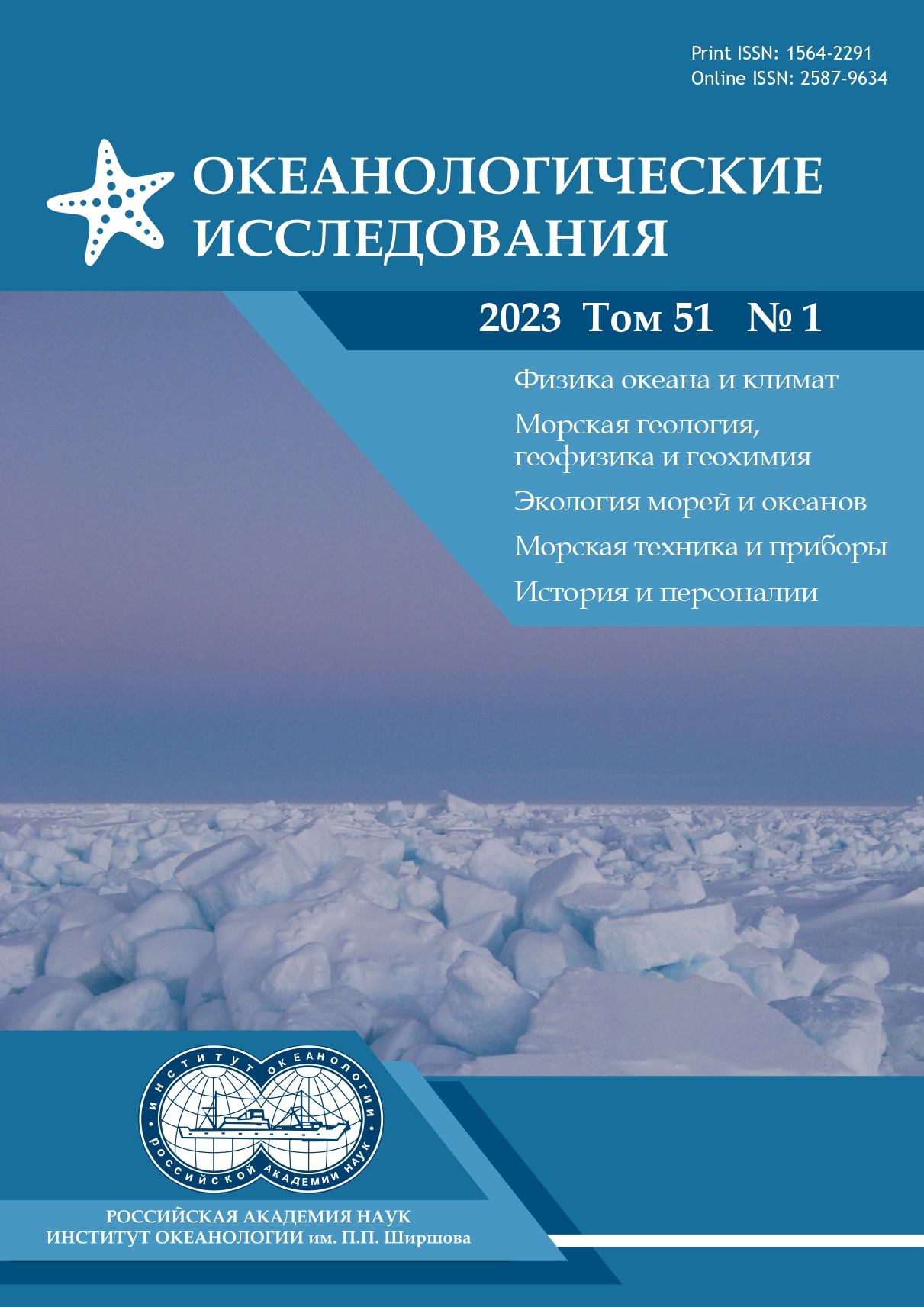OIL POLLUTION OF THE GULF OF OMAN BASED ON MONITORING WITH SYNTHETIC APERTURE RADAR
Abstract
The results of satellite radar monitoring oil pollution in the Gulf of Oman carried out in the period from January 2017 to April 2020 are analyzed. Synthetic aperture radar (SAR) images from the European satellites Sentinel-1A and Sentinel-1B and a geoinformation approach were used for this that makes it possible to fairly unambiguously determine oil spill causes and their sources. During the monitoring 2584 oil spill patches was detected on 730 SAR images whose total area is about 4972 km2. It is shown that the main oil spill source in the Gulf of Oman is intensive shipping by sea, including the tanker fleet, and the United Arab Emirates waters and the approaches to the Strait of Hormuz turned out to be the most polluted waters of the gulf.
References
- Clift, P. D., D. Kroon, J. Craig, and C. Gaedicke, 2002: The tectonic and climatic evolution of the Arabian Sea Region. The Geological Society, London, 534 p.
- Egorin, A. Z., 2015: Ob’edinennye Arabskie Emiraty: geografiya, istoriya, naselenie (United Arab Emirates: geography, history, population). Uchebnoe posobie, Kazan, 108 p.
- Fujairah, Marinetraffic, 2022. URL: https://www.marinetraffic.com/ru/ais/details/ports/790?name=FUJAIRAH&country=United-Arab-Emirates.
- Gerlach, S. A., 1981: Marine Pollution: Diagnosis and Therapy. Springer Berlin, Berlin, 220 p.
- Global Forecast System (GFS) NOAA. URL: https://www.ncei.noaa.gov/products/weather-climate-models/global-forecast.
- Hooglund, E. and A. Toth, 1994: United Arab Emirates: Geography. Persian Gulf States: Country Studies, Washington DC, 204–208.
- Ivanov, A. Yu., K. Ts. Litovchenko, and S. A. Ermakov, 1998: Oil spill detection in the sea using Almaz-1 SAR. J. Advanced Marine Sci. & Technol., 4 (2), 281–288.
- Ivanov, A. Yu., 2007: Sliki i plenochnie obrazovaniya na kosmicheskih radiolokacionnih izobrajeniyah (Slicks and film formations in space radar images). Issledovanie Zemli iz kosmosa, 3, 73–96.
- Ivanov, A. Yu. and V. V. Zatyagalova, 2007: Kartografirovaniye plenochnykh zagryazneniy morya s ispol’zovaniyem kosmicheskoy radiolokatsii i geograficheskikh informatsionnykh sistem (Mapping oil spills in the marine environment using satellite radar imagery and geographic information system). Issledovanie Zemli iz kosmosa, 6, 46–63.
- Ivanov, A. Yu., A. A. Kuchejko, N. A. Filimonova, A. Yu. Kuchejko, N. V. Evtushenko, N. V. Terleeva, and A. A. Uskova, 2017: Prostranstvenno-vremennoe raspredelenie plenochnyh zagryaznenij v Chernom i Kaspijskom moryah po dannym kosmicheskoj radiolokacii: sravnitel’nyj analiz (Spatiotemporal distribution of oil pollution in the Black and Caspian Seas according by SAR data: a comparative analysis). Issledovanie Zemli iz kosmosa, 2, 13–25, https://doi.org/10.7868/S0205961417020038.
- Ivanov, A. Yu., N. V. Terleeva, N. V. Evtushenko, and V. M. Evtushenko, 2018: Sputnikovyj monitoring neftyanyh zagryaznenij Persidskogo zaliva (Satellite monitoring of oil pollution in the Persian Gulf). Zemlya iz kosmosa, 10 (26), 48–53.
- Ivanov, A. Yu., N. A. Filimonova, A. Yu. Kucheiko, N. V. Evtushenko, and N. V. Terleeva, 2018: Oil spills in the Barents Sea based on satellite monitoring using SAR: spatial distribution and main sources. International Journal of Remote Sensing, 39 (13), 4484–4498, https://doi.org/10.1080/01431161.2017.1371869.
- Ivanov, A. Yu., E. R. Matrosova, A. Yu. Kucheiko, N. A. Filimonova, N. V. Evtushenko, N. V. Terleeva, and N. V. Libina, 2020: Poisk i obnaruzhenie estestvennyh nefteproyavlenij v moryah Rossii po dannym kosmicheskoj radiolokacii (Search and detection of natural oil seeps in the Russian seas using spaceborne SAR imagery). Issledovanie Zemli iz kosmosa, 5, 43–62, https://doi.org/10.31857/S0205961420050061.
- Ivanov, A. Yu., A. Yu. Kucheiko, D. V. Ivonin, N. A. Filimonova, N. V. Terleeva, and N. V. Evtushenko, 2022: Oil spills in the Barents Sea: Results from multiyear monitoring with SAR. Marine Pollution Bulletin, 179, 113677.
- Issa, S., 201: Monitoring oil spills offshore the United Arab Emirates using multi satellite data. International Journal of Geographical Information System Applications and Remote Sensing, 1 (1), 1–20.
- Klimenko, S. K., A. Yu. Ivanov, and N. V. Terleeva, 2022: Plenochnye zagryazneniya Kerchenskogo proliva po dannym pyatiletnego radiolokacionnogo monitoringa: sovremennoe sostoyanie i osnovnye istochniki (Oil Pollution of the Kerch Strait Based on Five-Year Monitoring with SAR: Current Status and Main Sources). Issledovanie Zemli iz kosmosa, 3, 37–54, https://doi.org/10.31857/S0205961422030071.
- MARPOL, 2008: International Convention for the Prevention of Pollution from Ships, MARPOL 73/78. Kn. I i II. SPb, ZAO “CNIIMF” (In Russian).
- Nelson-Smith, A., 1977: Oil pollution and marine ecology. Moscow, Progress, 302 p.
- Ninkabou, D., P. Agard., C. Nielsen, J. Smit, C. Gorini, M. Rodriguez, B. Haq, N. Chamot-Rooke, C. Weidle, and C. Ducassou, 2021: Structure of the offshore obducted Oman margin: Emplacement of Semail ophiolite and role of tectonic inheritance. Journal of Geophysical Research: Solid Earth, 126 (2), e0187. https://doi.org/10.1029/2020JB02018.
- Patin, S. A., 2017: Neft’ i ekologiya kontinental’nogo shel’fa (Oil and ecology of the continental offshore. 2nd edition, Moscow, VNIRO.
- Port of Fujairah, 2022. URL: https://fujairahport.ae/port-overview/facts-figures/.
- Sorohtin, O. G. and S. A. Ushakov, 2002: Razvitie Zemli. Moscow, Izd-vo MGU, 506 p.
- Terken, J. M. J., N. L. Frewin, and S. L. Indrelid, 2001: Petroleum systems of Oman: Charge timing and risks. The AAPG Bulletin, 85 (10), 1817–1845.
- Terleeva, N. V. and A. Yu. Ivanov, 2017: Zhidkie sudovye gruzy i othody, prichiny poyavleniya sudovyh razlivov v more i problemy ih distancionnogo zondirovaniya (Liquid cargo and waste, reasons of ship-made oil spills in the sea and problems of their remote sensing). Ecology and Industry of Russia, 21 (8), 13–19.
Transfer of copyrights occurs on the basis of a license agreement between the Author and Shirshov Institute of Oceanology, RAS










